MARIANI’SVirtual
Gourmet
July 28,
2013
NEWSLETTER\
HOME
| BOOKS
| ABOUT US
| CONTACT
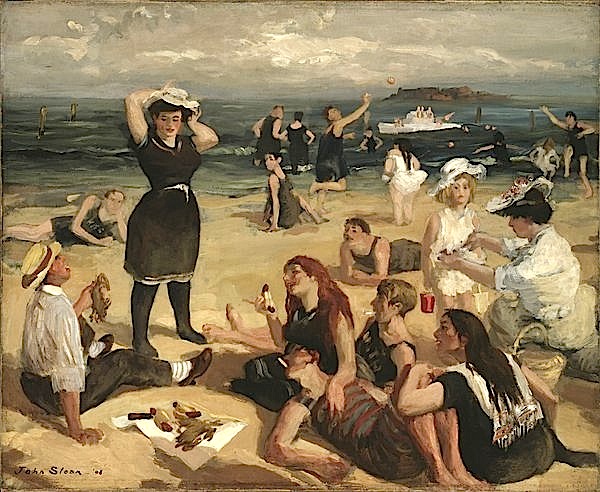
"South
Beach Bathers" by John Sloan (1908)
❖❖❖
THIS WEEK
DRIVING
CALIFORNIA'S PACIFIC COAST, Part Three
by Christopher Mariani
NEW
YORK CORNER
MONTMARTRE
by John Mariani
NOTES
FROM THE WINE CELLAR
Re-Thinking Red Wines in
Summer
by John Mariani
❖❖❖
DRIVING CALIFORNIA'S PACIFIC COAST
Part Three
by Christopher Mariani
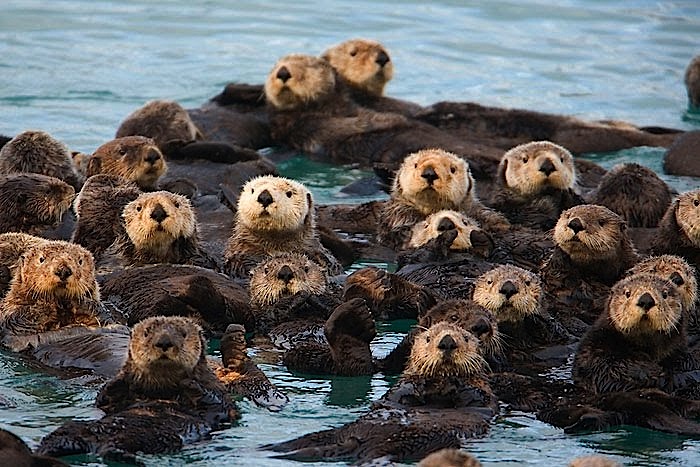
After four days of
driving up the California coast, Katrina and I
pulled into Carmel-by-the-Sea and nestled into
this charming city on the Monterey Peninsula. We
arrived in the late afternoon as the sun’s rays
were beginning to wane. We parked downtown and
decided to stretch our legs with a relaxing walk
through quiet streets. Art galleries and
boutique shops were in abundance, as were small
eateries and specialty bake shops. There were
sweet shops, fudge shops, and smoke shops.
The cool evening breeze was gentle,
beckoning us to break out the only light
sweaters we had packed for our trip.
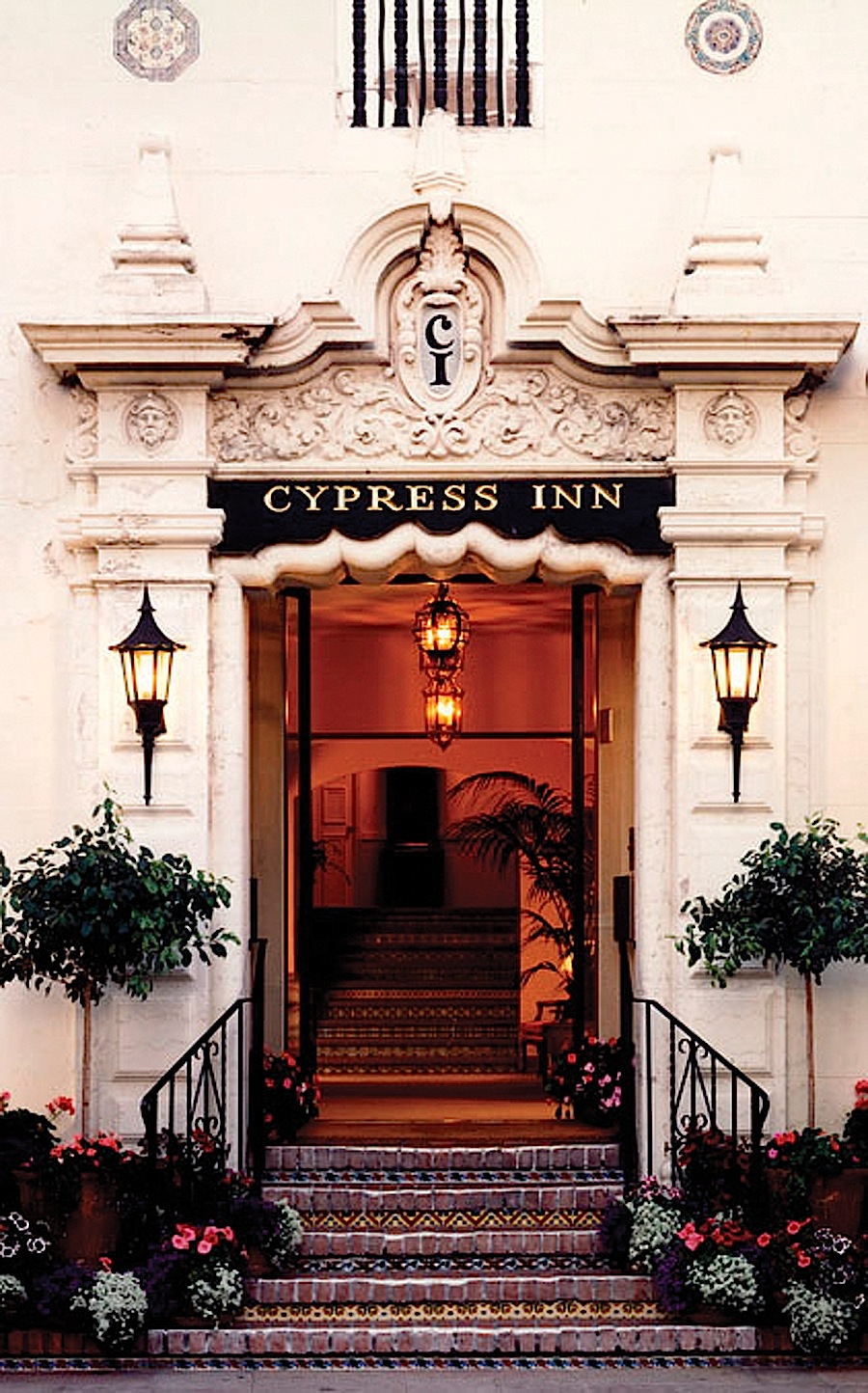 As the day
turned to night, we headed to the legendary Cypress
Inn for our one-night stay in Carmel--hands
down, my favorite stop along the way. We were
whisked past the check-in counter and brought
directly to our lovely room, where we were greeted
by a lighted fireplace and a bottle of amber
sherry. Our room keys were quietly placed as our
gracious bellhop closed our door and left us in
the privacy of our magnificent rooms. Our suite
was fitted with a balcony, overlooking the street
below, a warm living room, a connecting bedroom (below) and a
bathroom fit for a prince. As modern and
sophisticated as the accommodations were, we still
felt as though we were in the comforting hands of
a bed and breakfast. In this case,
As the day
turned to night, we headed to the legendary Cypress
Inn for our one-night stay in Carmel--hands
down, my favorite stop along the way. We were
whisked past the check-in counter and brought
directly to our lovely room, where we were greeted
by a lighted fireplace and a bottle of amber
sherry. Our room keys were quietly placed as our
gracious bellhop closed our door and left us in
the privacy of our magnificent rooms. Our suite
was fitted with a balcony, overlooking the street
below, a warm living room, a connecting bedroom (below) and a
bathroom fit for a prince. As modern and
sophisticated as the accommodations were, we still
felt as though we were in the comforting hands of
a bed and breakfast. In this case,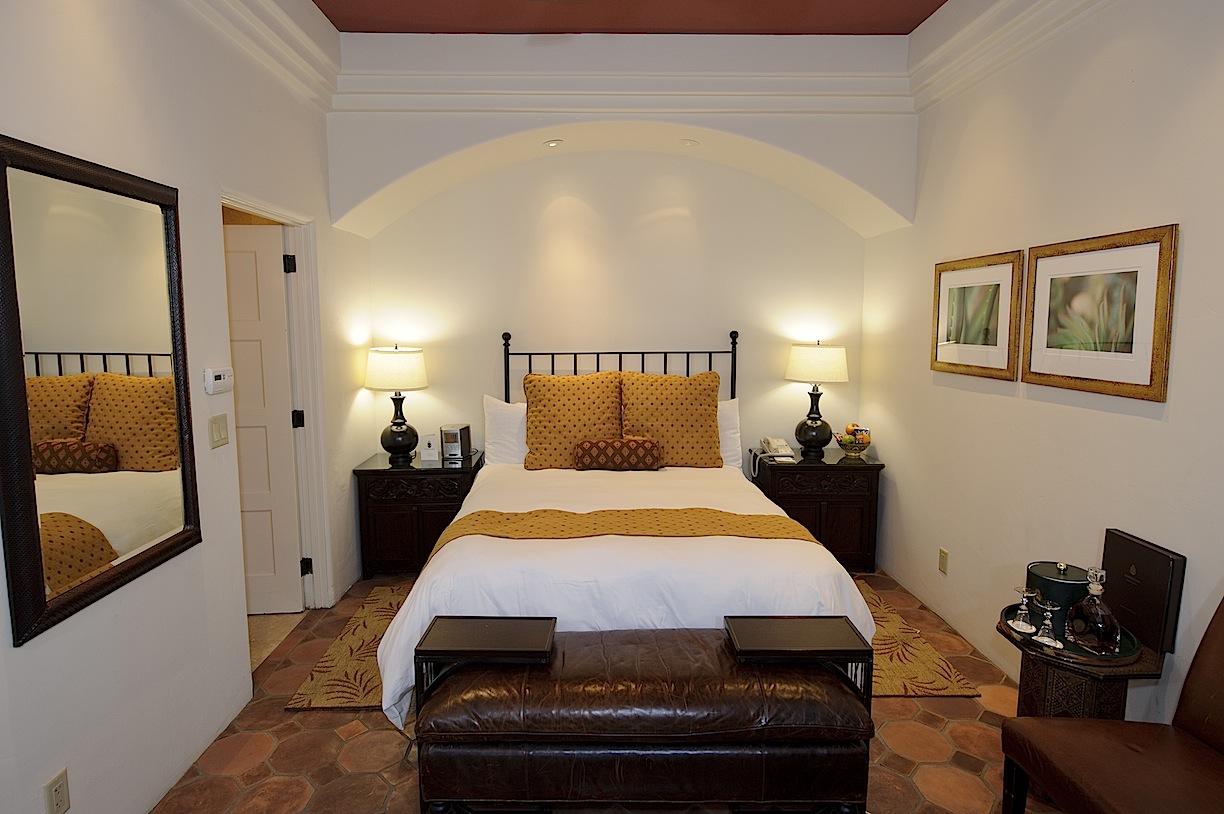 a bed and
breakfast on steroids.
a bed and
breakfast on steroids.
The Inn dates back to 1906, when
artist Sidney J. Yard built Carmel’s first art gallery
on the site, rebuilt in 1929 to look as it now does,
then called "one of the show places of the Monterey
Peninsula." Then, in the 1980s, business
man Dennis LeVett and his wife, Hollywood star Doris
Day, took over the Inn and gave it its current name.
After
a quick nap, we dressed and headed downstairs to
Terry’s Restaurant and Lounge. We sat at the inn’s
bar and ordered two old fashioneds and admired the
cocktail list’s initial quote by Humphrey Bogart,
“The problem with the world is that everyone is a
few drinks behind.” After attempting catch-up with
a second round of drinks, we thanked our bartender
and headed one block over to L'Auberge
Carmel (below,
left), whose restaurant Aubergine
was set for a dinner to remember.
After years of high praise from
the media, the accolades for Aubergine continue to
roll in. Just this year, Food & Wine’s
best new chef of 2013 award went to chef Justin
Cogley. Congratulations chef!
 We entered Aubergine (below) and
were greeted by a tall, handsome gentleman who
knew exactly who we were. We sat at our
spacious table and immediately took notice of the
attractive simplicity of our surroundings. Beige
and sandstone colors coated the walls, the
furniture splashed with hints of polished dark
wood. The space is small and intimate, exactly why
the experience is so special and impressive on
every level. That evening, we ordered off the
four-course prix-fix menu ($98) and opted for a
conservatively priced bottle of wine (not easy to
find on such a stout wine list) rather than the
sommelier’s wine pairing, worth $110. Dungeness
crab bathed in a pool of rose water and coconut
with a subtle hint of the floral geranium flower.
Bone marrow came smoked, served in a highly
concentrated broth of burnt vegetables and topped
with beautifully presented pickled maitake
mushrooms. Next, a single Maine diver's scallop
sat in its shell floating in a lemon balm soup.
We entered Aubergine (below) and
were greeted by a tall, handsome gentleman who
knew exactly who we were. We sat at our
spacious table and immediately took notice of the
attractive simplicity of our surroundings. Beige
and sandstone colors coated the walls, the
furniture splashed with hints of polished dark
wood. The space is small and intimate, exactly why
the experience is so special and impressive on
every level. That evening, we ordered off the
four-course prix-fix menu ($98) and opted for a
conservatively priced bottle of wine (not easy to
find on such a stout wine list) rather than the
sommelier’s wine pairing, worth $110. Dungeness
crab bathed in a pool of rose water and coconut
with a subtle hint of the floral geranium flower.
Bone marrow came smoked, served in a highly
concentrated broth of burnt vegetables and topped
with beautifully presented pickled maitake
mushrooms. Next, a single Maine diver's scallop
sat in its shell floating in a lemon balm soup.  The highlight of our
meal was chef Cogley’s Japanese kampachi,
gracefully decorated with dates and smoked roe,
finished with traces of vanilla and saffron. Chef
Cogley did a superb job of never overpowering his
main ingredient, even when toying with such
powerfully distinct flavors.
The highlight of our
meal was chef Cogley’s Japanese kampachi,
gracefully decorated with dates and smoked roe,
finished with traces of vanilla and saffron. Chef
Cogley did a superb job of never overpowering his
main ingredient, even when toying with such
powerfully distinct flavors.
We were also lucky enough to
enjoy Aubergine’s beautifully marbleized Japanese
Kobe steak, a rarity in terms of quality and
authenticity. (The price reflects such
legitimacy.) Desserts were equally impressive,
including a Nyangbo chocolate bar topped with
grapefruit and peanut butter. Also notable, a
sweet cooked pear with celeriac mouse and wood
sorrel. Cogley’s dishes were leaders in
presentation and flavor, a common remark by anyone
who has had the opportunity to dine at Aubergine.
After our final glass of wine, we slowly walked
back the Cypress Inn for a good night’s sleep.
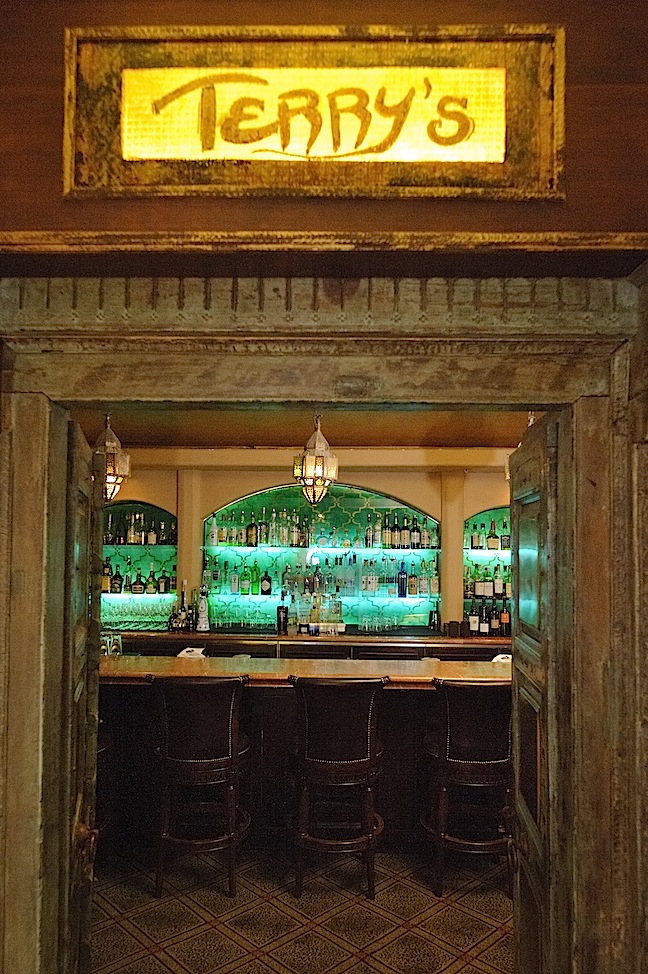 In
the morning, we headed back down to Terry’s for
their famous breakfast layout, all centered around
just-made, hot, buttery popovers that come out in
batches of twelve, filling the entire first floor
of the inn with the tantalizing aroma of fresh
baked goods. I must have had at least four
popovers before my girlfriend recommended I save
some for the other guests. I reluctantly moved on
to sliced fruit, French-style scrambled eggs and
home fries. This meal gave us more than enough
nutrition needed for our next leg of the road
trip, Napa Valley.
In
the morning, we headed back down to Terry’s for
their famous breakfast layout, all centered around
just-made, hot, buttery popovers that come out in
batches of twelve, filling the entire first floor
of the inn with the tantalizing aroma of fresh
baked goods. I must have had at least four
popovers before my girlfriend recommended I save
some for the other guests. I reluctantly moved on
to sliced fruit, French-style scrambled eggs and
home fries. This meal gave us more than enough
nutrition needed for our next leg of the road
trip, Napa Valley.
A few exhausting hours later,
all due to the miscalculations of our un-trustworthy
navigation system, we pulled into the parking lot
of Auberge du Soleil
(below),
where I experienced one of the loveliest meals in
my entire life.
The vineyard-caressed Auberge
was the first deluxe places to stay in the Valley,
opened in 1985 when wine country tourism was
burgeoning. The resort is done in a
Provençal style dear to owner Claude Rouas'
French heart, and recently remodeled. We walked
through the front doors of the Auberge and were
immediately awed by the stunning view that lay
ahead. its pool area is a remarkable setting
fitted neatly into the hillside. The all-wood balcony
looks out over Napa Valley and all its beauty. We
sat down, wide-eyed, and stared out at vineyards
that stretched for miles and miles, with the great
hills of Napa in the distance.
We started with two glasses of
the property’s very own reserve sparkling wine
from one of the finest, award-winning
wine lists in the world, and quickly moved on to
half-glass options, presented on Ipads, of Sonoma
chardonnay, pinot noir from Carneros and big cabs
from St. Helena. We were taking in Napa with each
breath of crisp air and each sip of delicious
wine. Our late lunch began with a generous portion
of Chef Robert Curry's tender lamb tartare and a
roasted Kurobuta pork belly with fresh avocado,
buttery brioche and smoked tomato. For a
mid-course, juicy pulled lamb topped potato gnocchi, fava
beans, Niçoise olives and a subtle orange
sauce. Entrees included savory short ribs and
bacon-wrapped veal served with sweet plums, rich
mascarpone cheese, pecans and a Marsala sauce.
one of the finest, award-winning
wine lists in the world, and quickly moved on to
half-glass options, presented on Ipads, of Sonoma
chardonnay, pinot noir from Carneros and big cabs
from St. Helena. We were taking in Napa with each
breath of crisp air and each sip of delicious
wine. Our late lunch began with a generous portion
of Chef Robert Curry's tender lamb tartare and a
roasted Kurobuta pork belly with fresh avocado,
buttery brioche and smoked tomato. For a
mid-course, juicy pulled lamb topped potato gnocchi, fava
beans, Niçoise olives and a subtle orange
sauce. Entrees included savory short ribs and
bacon-wrapped veal served with sweet plums, rich
mascarpone cheese, pecans and a Marsala sauce.
Desserts were also terrific,
but there is one I’d like to single out. And
that was the dark chocolate-filled dumplings
accompanied by extra virgin olive oil. The
combination was one I was leery about until I
tasted it, but the chef’s vision and innovation
trumped all my doubts that it would work. The meal
ended with two glasses of Dolce dessert wine and
our gazing over the tranquil Napa Valley.
Our next stop was Napa’s
renowned Meadowood resort just down the Silverado
Trail and more great food at Goose & Gander.
Stay tuned.
Part four of this article will appear soon.
❖❖❖
by John Mariani
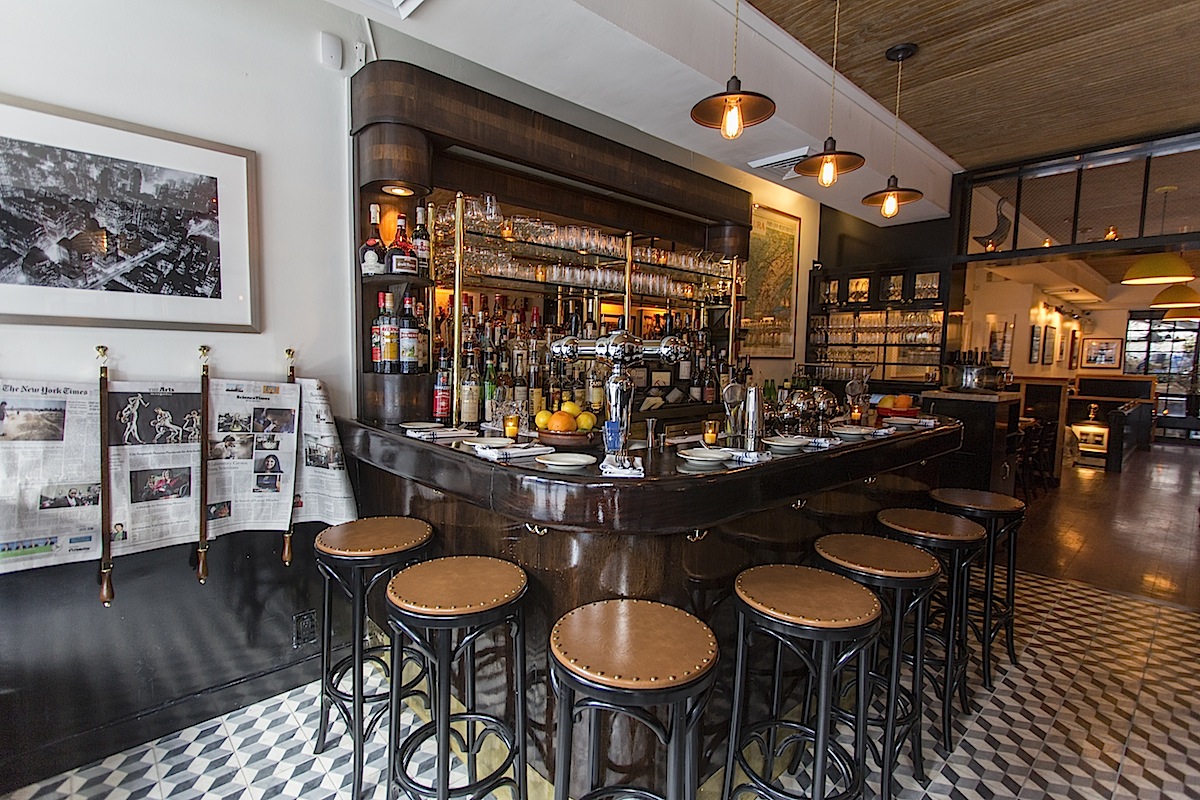 MONTMARTRE
MONTMARTRE158 Eighth Avenue (off 18th Street)
646-596-8838
Gabe Stulman is a cautiously ambitious restaurateur, for while he doesn’t rule empires as large as Michael White’s and Jean-Georges Vongerichten’s, in a more concentrated way he has expanded rapidly, now with Jeffrey’s Grocery, Joseph Leonard, Perla, Fedora and Chez Sardine within his domain. Montmartre is the latest, following Chez Sardine by only a few months, a blend of French bistro and Asian culinary styles, under Chef Tien Ho (below).
The menu has evolved from its initial offerings, when it was more French, but these days Ho has brought with him the innovative sensibility he plied at his prior workplaces, Momofuku Ssam Bar and Pêche, both under the peripatetic David Chang. If the marriage of Franco-Asian cuisine is not always seamless at Montmartre, the food is almost always
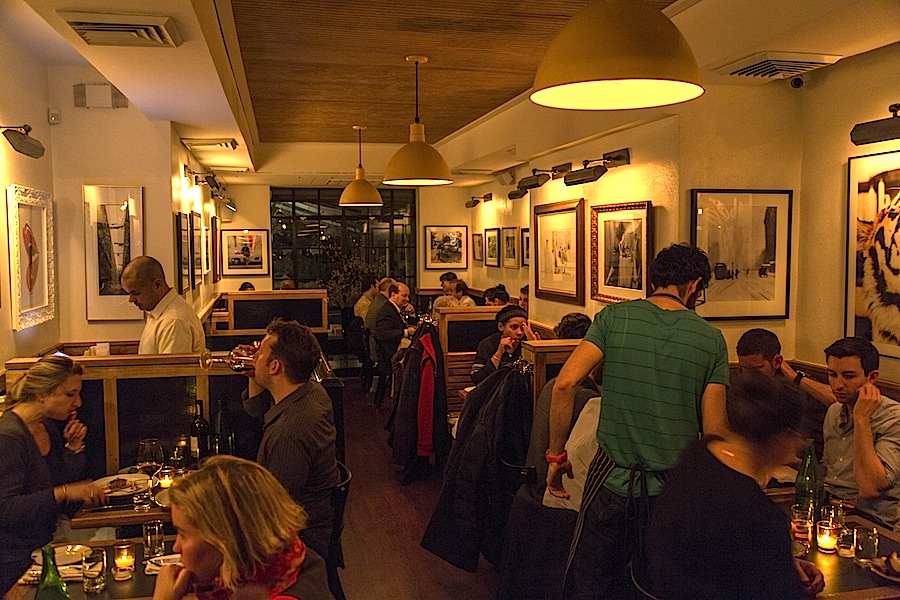 tantalizing.
tantalizing.There is a raw bar here, with offerings like fluke, King crab, and oysters. “Premiers” (appetizers) at the moment lists heirloom tomatoes, close to their peak (it’s been a weak year for tomatoes everywhere), here mixed with Adirondack kunik (a triple crème cheese), olives, watermelon rind and a little basil, all of it sharing the plate like the best of friends on a picnic blanket. The boudin chinois (below) is a terrific French blood sausage packed with assertive seasonings like five-spice powder and set upon a reduction of sweet-sour balsamic vinegar and Sichuan pepper oil.
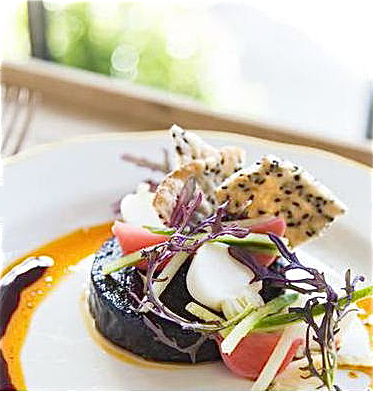 Snail toast, which could
easily have been a dud, was delicious, the
blandness of the snails perked up with spices and
garlic cream, served with a rich tomato confit
on country toast.
Snail toast, which could
easily have been a dud, was delicious, the
blandness of the snails perked up with spices and
garlic cream, served with a rich tomato confit
on country toast. Many kitchens just can’t get the hang of cooking trout, but Ho’s rendering, with beluga lentils, roe, parsley and ginger-laced beurre blanc, is a textbook example of how good this fish out of water can be. So, too, mussels with frites (below, left)—that classic of French bistros—is intense with flavors, bringing in those Asian elements of coconut milk, chili and coriander to liven things up. And those frites are irresistible. So, too, a “Garniture” of eggplant with red curry, tomato, fish sauce and Thai basil would be justified as a main course on its own, so savory was the assemblage.
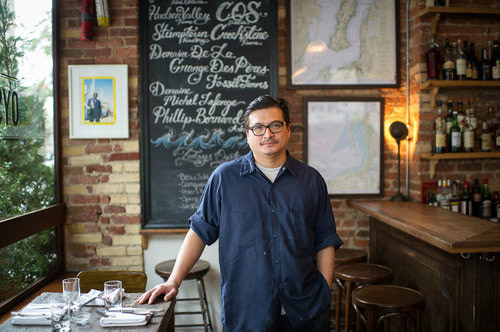
The pot-au-pho (a play on the French pot au feu) is a signature dish at Montmartre and a generously proportioned one, too, served for two, with short rib, oxtail, leeks, Thai basil and sweet hoisin sauce mixed in, which makes for a better autumnal dish than a hot summer’s indulgence.
I mentioned to Stulman (whose Perla was one of Esquire’s Best New Restaurants when it opened) that a lot of new places these days seem to be listing dishes prepared only for two, though he reminded me that restaurants, especially bistros, have long done so on their menus. Montmartre has three such dishes, the pot-au-pho, grilled whole turbot, and roasted and braised duck.
The desserts work well within the stylistic context here—crispy mille-feuille with chocolate mousse and cherry compote, rhubarb crumble with lime crème fraîche, and cheesecake with strawberry jam and tuile cookie.
 Given the modest size of Montmartre,
I suppose a modest wine list is to be expected,
and there are plenty of out-of-the-ordinary wines
from places like the Languedoc, the Jura, and the
Finger Lakes, though I’m not sure how many people
want to pay $64 for a bottle of La Carinne Farm
2011 Semillon Blend.
Given the modest size of Montmartre,
I suppose a modest wine list is to be expected,
and there are plenty of out-of-the-ordinary wines
from places like the Languedoc, the Jura, and the
Finger Lakes, though I’m not sure how many people
want to pay $64 for a bottle of La Carinne Farm
2011 Semillon Blend.Stulman is not known for opening large restaurants, and Montmartre is anything but spacious. There is an open-air patio, delightful when the summer heat allows people to sit out there. Otherwise, inside, people are saying “excuse me” whenever a chair moves and waiters angle themselves between tables.
There is a bar up front, manned by a master bartender named Brian Bartels, a small dining area downstairs, and the main dining area is done with off-white walls and slatted wood benches, with an array of black and white Parisian photos and prints on the walls.
The one serious demerit at Montmartre is the noise. The crowd gets louder and louder as people struggle to be heard above the din, not helped by a lack of sound absorbent surfaces. At the height of the evening, enjoying your meal can lead to a yearning to be set free from the 100+ decibel level, which is too bad, because it would be nice to linger over a glass of cider or cognac.
Still, Montmartre is packed most nights, and Stulman wisely allows for a number of walk-ins. Convivial it most certainly is, and the menu is now where it should be, which means full of dishes you won’t find anywhere else.
Open for lunch and dinner daily, brunch on Sat. & Sun.; Dinner appetizers run $9-$24, main courses $14-$34.
❖❖❖
Re-Thinking Red Wine
in Hot Weather
by John Mariani
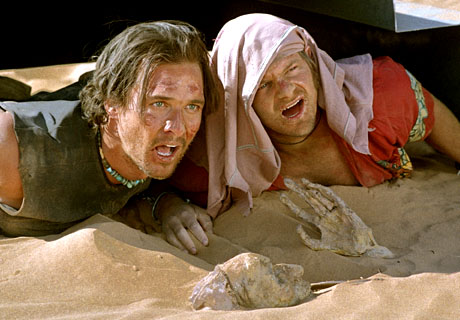 At a time when it seems most of
the world is sweltering, it is worth considering
the hoary argument that red wines are
inappropriate for drinking during hot weather.
At a time when it seems most of
the world is sweltering, it is worth considering
the hoary argument that red wines are
inappropriate for drinking during hot weather.
The rationale
seems commonsensical enough: when it’s hot and
humid, red wines are too heavy and, well, too warm
to drink; red wines aren't all that appealing with
the kinds of cold foods and salads served in
summer; high alcohol reds are not what you want to
be drinking in the broiling sun.
White wines
from an ice chest seem a more amiable choice, a
more refreshing option, and go best with summery
foods like fish, chicken, Caesar salad, and pasta
primavera. Indeed,
if there is a better marriage in gastronomy than a
steamed lobster with a great chardonnay, I cannot
imagine it; if I’m having clams or mussels, I want
a zesty sauvignon blanc or pouilly-fumé.
With oysters, the classic match-up is chablis.
Rosés,
which I like to drink year-round if they have some
body, is often the chilled alternative to reds,
and sparkling wines with low alcohol, like
prosecco and Spanish cavas, are terrific
aperitifs. And
white wines are, by and large, much better choices
with cheeses.
Nevertheless,
summer is a time for grilling and barbecue, steaks
and hamburgers. Plus the fact that people dine in
restaurants with plenty  of
air-conditioning, which evens out the playing
field for wines. “I’m still seeing a lot of red
wine sales this summer,” says Dale LoSasso, g-m
and wine director for the new Tongue &
Cheek restaurant (right) on steamy Miami Beach.
“Not huge cabernets or bordeaux, but plenty of
pinot noir and lighter style reds. We sell a lot
of cheeseburgers and people order riojas and
tempranillos from Spain and South America. What we
don’t see as much are people ordering big red
wines like shiraz and zinfandel.”
of
air-conditioning, which evens out the playing
field for wines. “I’m still seeing a lot of red
wine sales this summer,” says Dale LoSasso, g-m
and wine director for the new Tongue &
Cheek restaurant (right) on steamy Miami Beach.
“Not huge cabernets or bordeaux, but plenty of
pinot noir and lighter style reds. We sell a lot
of cheeseburgers and people order riojas and
tempranillos from Spain and South America. What we
don’t see as much are people ordering big red
wines like shiraz and zinfandel.”
Pinot noir is
an especially good choice for grilled red meats
because it usually has softer, less pronounced
tannins and lower alcohol levels than big-fisted
cabernet sauvignons. Pinots are also more
adaptable to barbecue spices, as are the Spanish
and South American reds LoSasso mentions. “We have
a lot of Latin American guests and they are used
to drinking lighter red wines with their meals
year-round.”
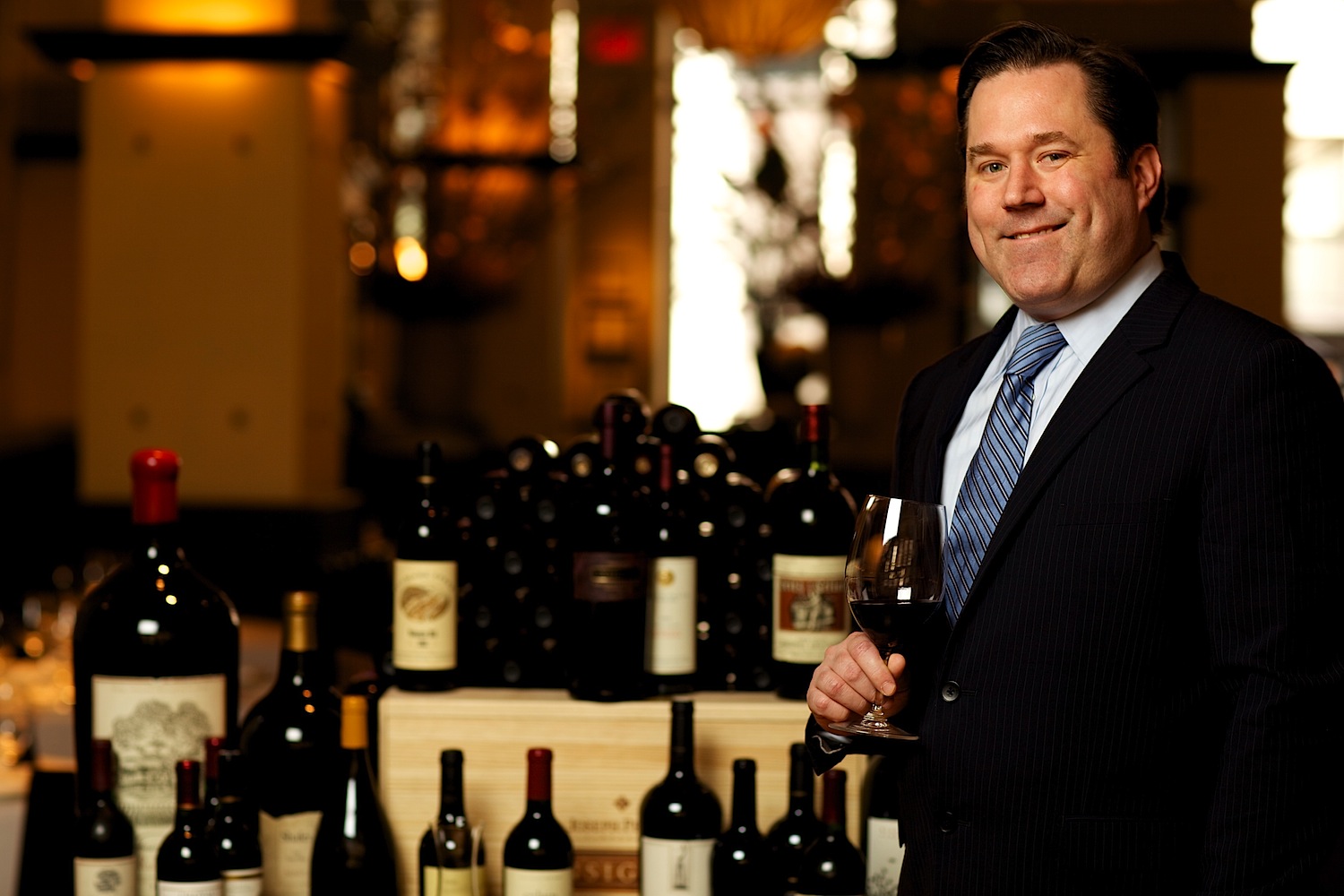 At
dinner this month at New York’s Gotham
Bar & Grill, I asked Eric Zillier (left), wine
director until this month, to choose wines to go
with our meal. With cheese-filled agnolotti with
morels, fava beans and leeks, he served a white
Burgundy, but with the pork chop with strong
flavors of roasted fennel, radicchio, bacon and
apple in a balsamic reduction, he went red—-a rich
pinot noir from Burgundy, 2006 Nuits–Saint-Georges
“Aux Boudots” Jérôme Chezeaux. “I am
always `dish specific’ with my wine suggestions,”
says Zillier. “With the earthy pasta dish I think
you can taste the intricacies of the dish better
with that white burgundy. With the pork dish
there’s a lot you can do, from an Alsatian
riesling with lots of spice to a cru
beaujolais or Loire Valley sancerre or chinon. The
Nuits Saint Georges I chose had acidity and its
own spice, and it’s only 13 percent alcohol.”
At
dinner this month at New York’s Gotham
Bar & Grill, I asked Eric Zillier (left), wine
director until this month, to choose wines to go
with our meal. With cheese-filled agnolotti with
morels, fava beans and leeks, he served a white
Burgundy, but with the pork chop with strong
flavors of roasted fennel, radicchio, bacon and
apple in a balsamic reduction, he went red—-a rich
pinot noir from Burgundy, 2006 Nuits–Saint-Georges
“Aux Boudots” Jérôme Chezeaux. “I am
always `dish specific’ with my wine suggestions,”
says Zillier. “With the earthy pasta dish I think
you can taste the intricacies of the dish better
with that white burgundy. With the pork dish
there’s a lot you can do, from an Alsatian
riesling with lots of spice to a cru
beaujolais or Loire Valley sancerre or chinon. The
Nuits Saint Georges I chose had acidity and its
own spice, and it’s only 13 percent alcohol.”
Still, there is
the steak quandary, which for many is no quandary
at all. Cabernet sauvignon still rules. “We seem
to be an anomaly.” 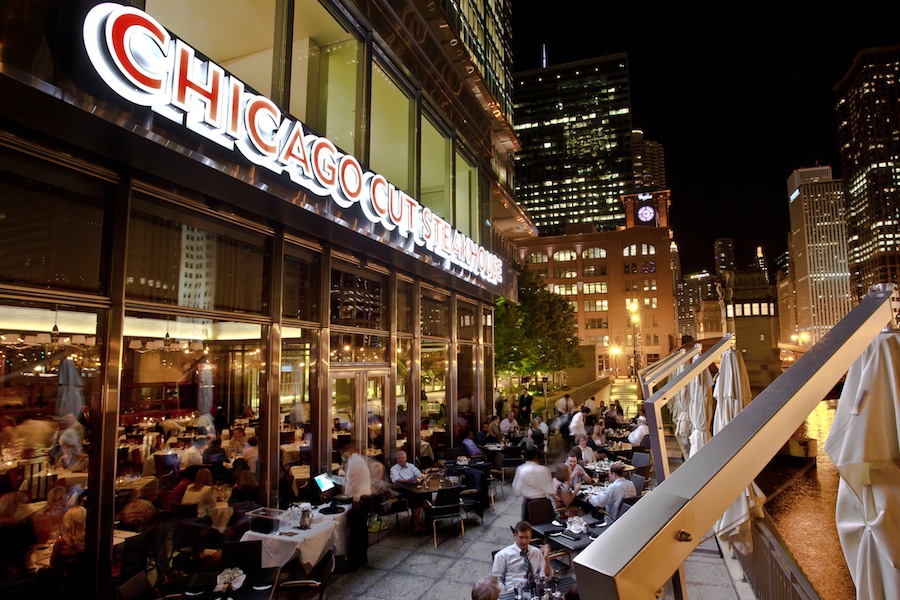 says Marc
Passer, beverage director for Fourth Wall
Restaurants, which owns the New York Smith
& Wollensky and Maloney
& Porcelli. “We can have a table of ten
guys who order Silver Oaks Cabernet with oysters,
and we sell a lot of older vintages of Jordan.
They love the big California style with their
steaks.”
says Marc
Passer, beverage director for Fourth Wall
Restaurants, which owns the New York Smith
& Wollensky and Maloney
& Porcelli. “We can have a table of ten
guys who order Silver Oaks Cabernet with oysters,
and we sell a lot of older vintages of Jordan.
They love the big California style with their
steaks.”
David
Flo,
general manager and partner of Chicago
Cut Steakhouse agrees: “Americans have a
love affair for steak with cabernet and it's never
going to change. Ninety percent of our guests
order the same thing when it’s 95 degrees outside
as when it’s 30 here in Chicago. But if I’m asked
for something lighter, I’ll suggest an Oregon
pinot noir, which has depth and rusticity but not
the heaviness of a cab.” Flom also insists that
the wine temperature should be cool, “ideally 66
degrees, which is what we store our reds at.”
Still, while
I’m fine with cabernet sauvignon with a
porterhouse cooked on the patio grill when it’s 98
degrees out, my preference is to tone down the
alcohol while still seeking body and texture. Even
in winter I’m not crazy about cabernets at 16
percent alcohol that take over rather than enhance
good beef. So
I go with a chianti classico, pretend I'm in
Tuscany and grill a thick bistecca alla
fiorentina.
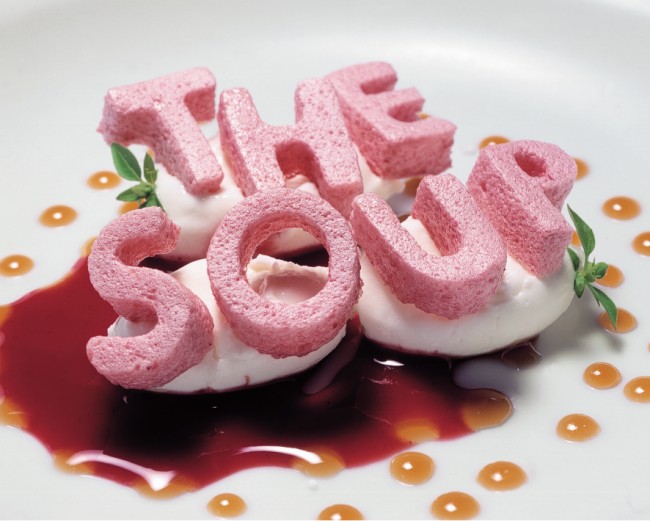 HUH????
HUH????"Critics of California kitchens, usually East Coast guys trained in the complexities of classic French cuisine, have been known to describe what local chefs do as more assemblage than cooking, as nothing more than arranging superb local produce in Instagram-friendly arrays."--Jonathan Gold, "Barnyard's deceptive simplicity," LA Times.
WHICH MAY EXPLAIN WHERE "JEOPARDY" CONTESTANTS
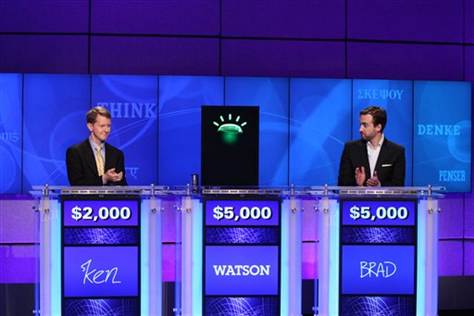
GO ON THEIR BREAK.
Researchers at the University of East London School of Psychology in England published a paper in Frontiers in Human Neuroscience contending that when adults drink water, they tend to have better concentration and perform better on mental tests. Study subjects who ate nothing the night before were given a cereal bar, the next, a cereal bar and about 3 cups of water. When the participants were given a reaction test where they had to press a button as soon as they saw something pop up on a computer screen, those given water had a reaction time 14 percent faster.
Any of John Mariani's
books below may be ordered from amazon.com.
 |
My latest book, which just won the prize for best book from International Gourmand, written with Jim Heimann and Steven Heller, Menu Design in America, 1850-1985 (Taschen Books), has just appeared, with nearly 1,000 beautiful, historic, hilarious, sometimes shocking menus dating back to before the Civil War and going through the Gilded Age, the Jazz Age, the Depression, the nightclub era of the 1930s and 1940s, the Space Age era, and the age when menus were a form of advertising in innovative explosions of color and modern design. The book is a chronicle of changing tastes and mores and says as much about America as about its food and drink.
“Luxuriating vicariously in the pleasures of this book. . . you can’t help but become hungry. . .for the food of course, but also for something more: the bygone days of our country’s splendidly rich and complex past. Epicureans of both good food and artful design will do well to make it their coffee table’s main course.”—Chip Kidd, Wall Street Journal.
“[The menus] reflect the amazing craftsmanship that many restaurants applied to their bills of fare, and suggest that today’s restaurateurs could learn a lot from their predecessors.”—Rebecca Marx, The Village Voice. |
"Eating Italian will never be the same after reading John Mariani's entertaining and savory gastronomical history of the cuisine of Italy and how it won over appetites worldwide. . . . This book is such a tasteful narrative that it will literally make you hungry for Italian food and arouse your appetite for gastronomical history."--Don Oldenburg, USA Today. "Italian
restaurants--some good, some glitzy--far
outnumber their French rivals. Many of
these establishments are zestfully described
in How Italian Food Conquered the World, an
entertaining and fact-filled chronicle by
food-and-wine correspondent John F.
Mariani."--Aram Bakshian Jr., Wall Street
Journal.
"Equal parts
history, sociology, gastronomy, and just
plain fun, How Italian Food Conquered the
World tells the captivating and delicious
story of the (let's face it) everybody's
favorite cuisine with clarity, verve and
more than one surprise."--Colman Andrews,
editorial director of The Daily
Meal.com. "A fantastic and fascinating
read, covering everything from the influence
of Venice's spice trade to the impact of
Italian immigrants in America and the
evolution of alta cucina. This book will
serve as a terrific resource to anyone
interested in the real story of Italian
food."--Mary Ann Esposito, host of PBS-TV's
Ciao
Italia. "John Mariani has written the
definitive history of how Italians won their
way into our hearts, minds, and
stomachs. It's a story of pleasure over
pomp and taste over technique."--Danny Meyer,
owner of NYC restaurants Union Square Cafe,
Gotham Bar & Grill, The Modern, and
Maialino.
|
 |
 |
 |
 |
 |
 |
 |
 |
 Everett Potter's Travel Report:
Everett Potter's Travel Report: 
 Eating Las Vegas
is the new on-line site for Virtual Gourmet
contributor John A. Curtas., who since 1995
has been commenting on the Las Vegas food
scene and reviewing restaurants for Nevada
Public Radio. He is also the
restaurant critic for KLAS TV, Channel 8 in
Las Vegas, and his past reviews can be
accessed at KNPR.org.
Click on the logo below to go directly to
his site.
Eating Las Vegas
is the new on-line site for Virtual Gourmet
contributor John A. Curtas., who since 1995
has been commenting on the Las Vegas food
scene and reviewing restaurants for Nevada
Public Radio. He is also the
restaurant critic for KLAS TV, Channel 8 in
Las Vegas, and his past reviews can be
accessed at KNPR.org.
Click on the logo below to go directly to
his site.

Tennis Resorts Online: A Critical Guide to the World's Best Tennis Resorts and Tennis Camps, published by ROGER COX, who has spent more than two decades writing about tennis travel, including a 17-year stretch for Tennis magazine. He has also written for Arthur Frommer's Budget Travel, New York Magazine, Travel & Leisure, Esquire, Money, USTA Magazine, Men's Journal, and The Robb Report. He has authored two books-The World's Best Tennis Vacations (Stephen Greene Press/Viking Penguin, 1990) and The Best Places to Stay in the Rockies (Houghton Mifflin, 1992 & 1994), and the Melbourne (Australia) chapter to the Wall Street Journal Business Guide to Cities of the Pacific Rim (Fodor's Travel Guides, 1991).


MARIANI'S VIRTUAL GOURMET
NEWSLETTER is published weekly. Editor/Publisher: John
Mariani.
Contributing Writers: Christopher Mariani, Robert Mariani,
John A. Curtas, Edward Brivio, Mort Hochstein,
Suzanne Wright, and Brian Freedman. Contributing
Photographers: Galina Stepanoff-Dargery,
Bobby Pirillo. Technical Advisor: Gerry McLoughlin.
© copyright John Mariani 2013
